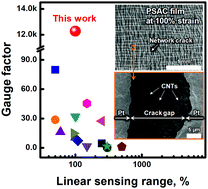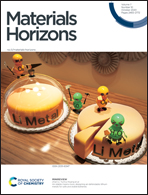Enhancement of linearity range of stretchable ultrasensitive metal crack strain sensor via superaligned carbon nanotube-based strain engineering†
Abstract
Conventional mechanical crack-based strain sensors have high mechanosensitivity but suffer from limited stretchability and poor linearity. Here, we present a simple yet highly efficient strategy to enhance the strain-sensing performance of metal-based crack sensors based on platinum (Pt)/superaligned carbon nanotube (SACNT) hybrid conducting films. The proposed sensor is simply fabricated by transferring dry-spun SACNT films onto elastomer substrates and then sputtering Pt films. The SACNT underneath the Pt film endows the Pt crack sensors with large stretchability (ε = 100%) and excellent linearity (R2 ≈ 0.996) while ensuring ultrahigh sensitivity (gauge factor ≈ 12 274) by modulating the cracking structure in the Pt film so that the cracked Pt parts can be bridged upon stretching even at high strains. In addition, the sensor response is found to be quite fast (≈257.7 ms) and stable even under long-term operation (2000 cycles at 50% strain). Based on their excellent strain-sensing performance and mechanical flexibility, the sensors are demonstrated to detect a wide range of human motions in real time. Moreover, two single sensors can be successfully assembled in a cross shape to detect complex multiaxial strains.

- This article is part of the themed collection: Materials Horizons 10th anniversary regional spotlight collection: Asia-Pacific


 Please wait while we load your content...
Please wait while we load your content...